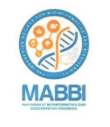Effectiveness of Tamarillo (Solanum betaceum Cav.) Fruits Extract Towards Growth of Trichophyton rubrum: in vitro Study
Abstract
Trichophyton rubrum is the most common cause of dermatophytosis. The use of synthetic-antifungals has several side effects and resistance. Exract of tamarillo (Solanum betaceum Cav.) fruits contains active compounds that have potential as antifungal, including alkaloids, saponins, tannins, phenolics, and flavonoids This study aims to determine the effectiveness of tamarillo extract as antifungals against the growth of T. rubrum. This study used ethanol extract of tamarillo fruits with a concentration based on volume/volume (v/v) percentage of 20%; 40%; 60%; and 80%, ketoconazole as positive control, and aquadest as negative control. The antifungal test was conducted by using well diffusion method on Saboraud-Dextrose-Agar medium and was incubated for 24 hours, 48 hours and 72 hours. Data were analyzed by Kruskall-Wallis-test with the results p=0.01, p=0.000, p=0.000 respectively according to the length of incubation time. Data were analyzed for Post-Hoc by Mann-Whitney-test showing the three groups of data had significant differences in results between the two treatment groups. Most effective extract group was the extract with concentration of 20% at incubation time of 24 hours with relatively strong antifungal properties. The results showed that the tamarillo fruits extract as antifungal are effective towards growth of T. rubrum which indicated by the presence of inhibition zone at a concentration of 20%; 40%; 60%; and 80 after being incubated for 24 hours with diameters of 13,375 mm, 15,725 mm, 17,025 mm and 19.25 mm, respectively.
Full Text:
PDFDOI: https://doi.org/10.47007/ijobb.v5i2.74
Refbacks
- There are currently no refbacks.
| Indonesian Journal of Biotechnology and Biodiversity Published by: Publishing Department of Esa Unggul University Arjuna Utara No 9 Street Kebon Jeruk Jakarta - 11510 Indonesia | |








.png)

